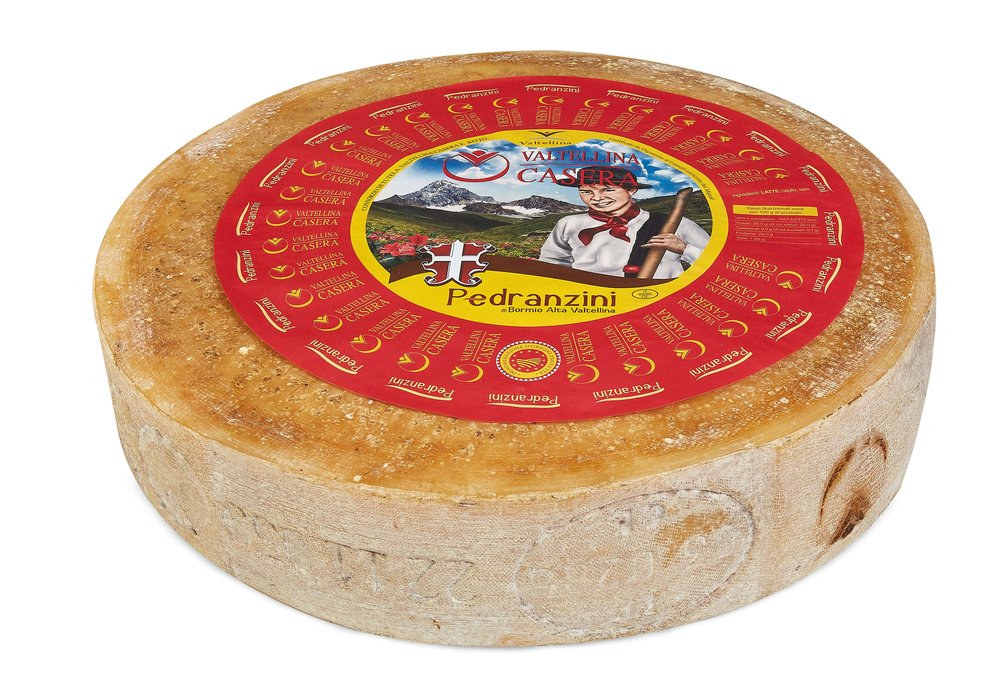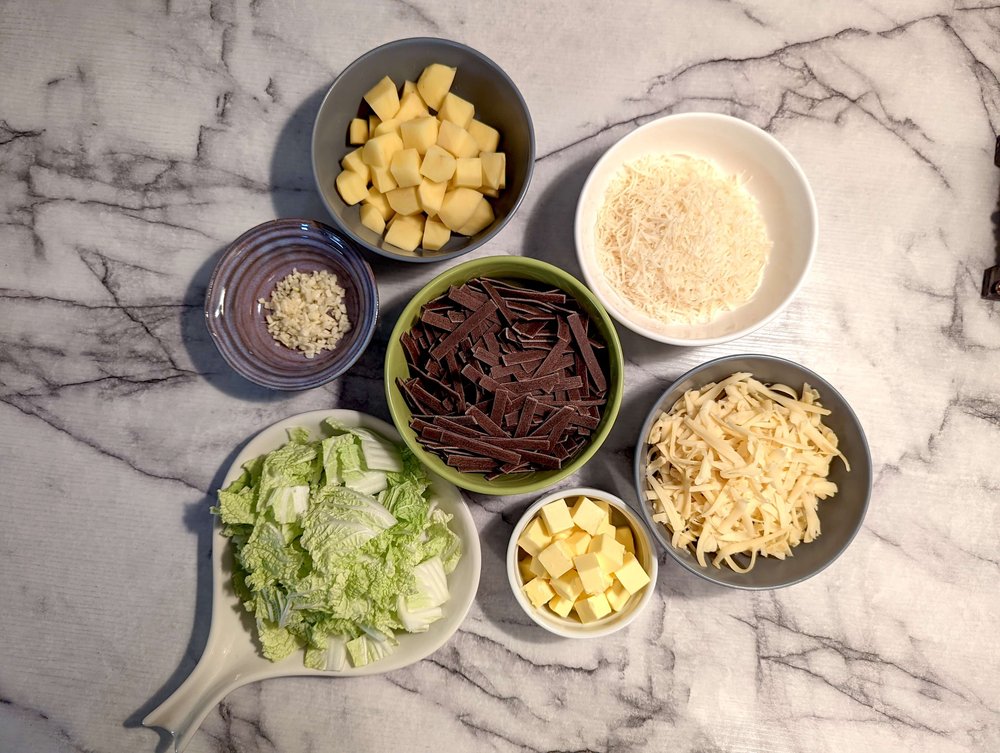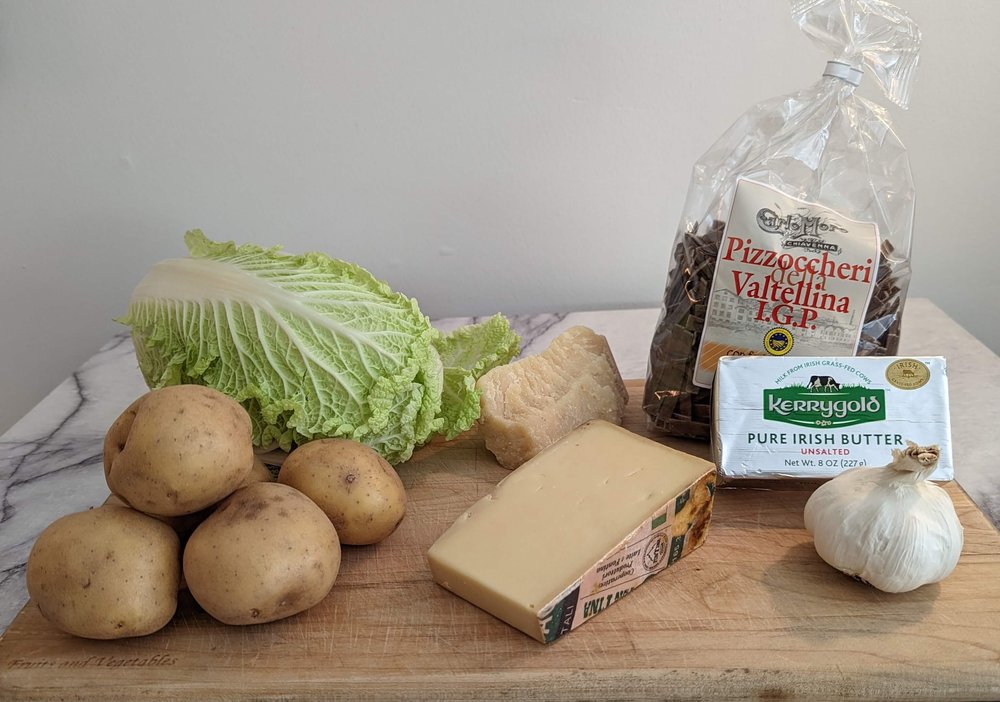If, when you think of Northern Italian cuisine, you think of hearty, meaty dishes such as Bolognese, lasagna, or osso bucco, then you’re not thinking quite north enough. In the northernmost regions of Italy, tucked into the foothills of the Alps and Dolomite mountains, the landscape changes considerably from sun-drenched piazzas, and trademark Italian tomatoes and olives are replaced with more winter-hearty crops.
I first encountered pizzoccheri in the tiny, Italian ski town of Bormio, about 125 miles northeast of Milan. (I was there for the opposite of skiing: to see a production of a traditional Italian form of theater called commedia dell’arte.) What was presented to me contained about 4 things I wasn’t expecting in an Italian pasta dish: cabbage, potatoes, buckwheat, and butter, and only 2 things I might have been expecting: garlic and cheese. Regardless of my expectations, however, pizzoccheri proved to be a unique and delicious experience—hearty, pungent, and savory—one that I was very inclined to replicate once back in the United States.

What is Pizzoccheri?
Since 2002, traditional pizzoccheri has been codified by the organization Accademia Del Pizzocchero di Teglio, whose primary mission is to bring light to this enigmatic dish as a representation of traditional Valtellinese cuisine. The Valtellina Valley, centered around the town of Sondrio, is an Alpine region where buckwheat has been a primary crop for over 400 years. It is a sturdy, peasant dish appropriate for cold weather and hard, mountain living, where pasta, cabbage, and potatoes are all boiled together, then layered with two types of cheese into a casserole-like presentation.
Despite their similar prefix, pizzoccheri has little in common with pizza, other than the cheese, and the fact that “pizz” or “pieces” are an important part of their construction or consumption. In the case of pizzoccheri, the specific shape of the pasta constitutes bits or pieces: short, ribbon-shaped noodles that must be no more than 2 to 3 millimeters in width, and no more than 7 to 8 millimeters in length.
Valtellina Casera DOP courtesy of Castagna Formaggi
The Cheese for Pizzoccheri Valtellina Casera DOP
The primary cheese that characterizes pizzoccheri as a dish is Valtellina casera, a skimmed, cow’s milk Alpine cheese that sees at least 2 months of aging, for a semi-firm, pliant texture. Made from pasture-grazing cow’s milk, like other Alpine cheeses Valtellina casera is nutty and flavorful, with the capacity to become pungent and piquant as it continues to ripen. Also like other Alpine cheeses, its cooked curd makes it an excellent melter, so combined with an almost scandalous amount of butter, creates a rich, silky sauce for the hearty pizzoccheri noodles.
Sadly, Valtellina casera is almost entirely unavailable in the U.S., so another Italian Alpine cheese from just a bit further west in the Aosta Valley—Fontina Val D’Aosta, usually stands in for Valtellina in American pizzoccheri recipes. A word on Fontina: I am plenty accustomed and attracted to strong-smelling cheeses, but the piece of Fontina I was able to source was just about the most pungent thing I’ve had in my kitchen. The taste, of course, is far less intense, but if that level of pungency is off-putting, any good, cow’s milk, Alpine melter such as Gruyère or Comté can also stand in.
Traditional pizzoccheri also calls for Grana Padano, which simply tops off the dish before a quick turn in the oven. If Grana Padano is also difficult to come by in your area, Parmigiano Reggiano is also a fine substitute.

The Pasta for Pizzoccheri
Pizzoccheri noodles, which also enjoy IGP status in Italy, can be found commercially made, either online, or in a well-stocked Italian speciality market such as Buon’Italia in New York City’s Chelsea Market. Buckwheat produces a flour that is a little more toothsome and savory than traditional wheat flour, and also adds character to the dish in terms of color.
The Accademia Del Pizzocchero di Teglio suggests making the noodles from scratch, with a simple dough composed of 4 parts buckwheat to 1 part white flour. The flour mixture is bound and kneaded with water only, then cut to the requisite short ribbon shape of 2 to 3 millimeters wide by 7 to 8 millimeters long.
Pizzocheri components photo credit Pamela Vachon
How to Make Pizzoccheri
Traditional pizzoccheri calls for the potatoes, cabbage, and pasta to all be boiled in the same pot, while butter and garlic sizzle on the stove top, before combining with the cheese into a casserole dish. I used a cast iron skillet for the garlic and butter, and transferred the noodles and potato mixture into the same skillet before baking, to further decrease the number of dishes.
I kept my recipe and method relatively close to the original in order to responsibly demonstrate a classic version of the dish. (I did cut down the amount of butter, which truly seemed scandalous even to someone of French heritage.) That being said, boiling cabbage is a surefire method for a lifelong aversion to cabbage, and since you’ve already got a skillet with butter and garlic working on the stovetop, I hardly think adding the cabbage there for a little caramelization would be a bad idea. Since you might have to punt already with the specific variety of cheese you use, and since the Accademia del Pizzocchero is more a scholarly organization than a policing one, feel free to experiment to your liking.

Pizzoccheri Recipe
Ingredients:
3 cups chopped napa cabbage, about 5 oz
1 ½ cups peeled and cubed potatoes, about 8 oz
1 lb (500 g) Pizzoccheri pasta
1 stick unsalted butter
2 cloves garlic, minced or pressed
8 oz Valtellina casera, or Fontina Val D’Aosta, shredded
2 oz Grana Padano or Parmigiano Reggiano, freshly grated
salt & pepper, to taste
Method:
-
Preheat oven to 400 degrees
-
Bring salted water to boil in a large stock or pasta pot. Add chopped cabbage and potatoes and boil for 5 minutes. Add pizzoccheri noodles and boil for 6-8 minutes more, until noodles are al dente, and potatoes can be pierced with a fork. Drain pasta, cabbage, and potatoes, and return to pot.
-
Meanwhile, in a large cast iron skillet, melt butter over medium heat. Add minced garlic, and cook briefly until garlic is aromatic.
-
Pour butter and garlic over cooked noodles and toss gently to coat. Season with salt and pepper to taste.
-
In the same skillet, layer ⅓ of noodle mixture. Top with ½ of Valtellina or Fontina cheese. Repeat with ⅓ more noodles, and the remaining Valtellina or Fontina cheese. Finish with final ⅓ of noodles, and top with Grana Padano or Parmigiano Reggiano cheese.
-
Bake for 10 minutes until cheese is melted and just starting to brown.
For more cheese-forward recipes, see How to Make The Perfect Cheese and Vegetable Strata, How to Make and Use Rich Parmigiano Reggiano Rind Broth, and The Matterhorn’s Original Moitié-Moitié Fondue Recipe.
